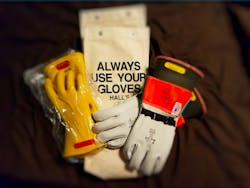Over the last several years, I have been blessed with the opportunity to visit many commercial, industrial, and government facilities across the United States to provide electrical safety training and audits. During that time, I have come to realize that there are several common misunderstandings or misapplications that must be addressed regardless of the type or location of the facility. Safety Sense will address these issues in a short format, addressing frequently asked questions. If there are topics you would like covered, please email me at [email protected].
Do I need to wear voltage-rated gloves when testing low voltages with a handheld meter?
The context of this question is typically related to 120VAC nominal circuits.
The NFPA 70E defines “Working On (energized electrical conductors or circuit parts)” as: "Intentionally coming in contact with energized conductors or circuit parts with the hands, feet, or other body parts, with tools, probes, or with test equipment, regardless of the personal protective equipment (PPE) a person is wearing."
NFPA 70E Sec. 130.4(F)(1) states that any part of a qualified person’s body that crosses into the Restricted Approach Boundary (RAB) shall be insulated.
The NFPA 70E Handbook has the following clarification after the Restricted Approach Boundary section: "This section recognizes that a tool or other object is considered to be an extension of the person’s body. If a person is holding an object, the requirements of this section apply to both the person and the object."
The handbook is clearly identifying objects being held by the worker as an extension of their person regardless of whether or not they are insulated. Therefore, holding test probes that are in contact with the energized or potentially energized conductors is equivalent to contacting those energized conductors with your hands. So, what is the proper method for protecting our hands from this hazard?
As per NFPA 70E Sec. 130.7(C)(7)(a), "Employees shall wear rubber insulating gloves with leather protectors where there is a danger of hand injury from electric shock due to contact with energized electrical conductors or circuit parts."
Therefore, if the qualified person’s hands, tools, probes, or test equipment cross into the RAB of systems rated 50V or greater (AC or DC), then the use of voltage-rated gloves is required. This includes using a handheld meter to check voltages on 120VAC circuits. So the answer to the subject question is YES. Voltage-rated gloves and leather protectors are required when testing any voltages greater than 50V because testing is touching.
Northcott is a professional engineer licensed in the state of Tennessee and a senior power engineer with Jacobs Technology, Inc., in Tullahoma, Tenn. He is also an NFPA 70E compliance subject matter expert, a principle member of the NFPA 70B Committee, electrical safety trainer, certified maintenance and reliability professional, and certified reliability leader. He can be reached at [email protected].
About the Author

Tommy Northcott
Senior Power Engineer
Northcott earned a BS Degree in Electrical Engineering with an emphasis in Power Systems from Tennessee Technological University. He is a Professional Engineer licensed in the State of Tennessee, a Certified Reliability Leader, and a Certified Maintenance and Reliability Professional and is a current principle member on the NFPA 70B committee (Recommended Practice for Electrical Equipment Maintenance). Tommy has broad experience working with large electric utility systems as a Systems Engineer, Arc Flash Program Manager, Operations and Maintenance Manager, and Reliability Engineering Manager. Tommy has extensive experience in operations and maintenance of electrical equipment, performing arc flash analysis calculations, developing and conducting electrical safety training and developing company electrical safety standards to ensure OSHA and NFPA 70E compliance. Currently, Tommy is a Senior Power Engineer with Jacobs Technology Inc.
